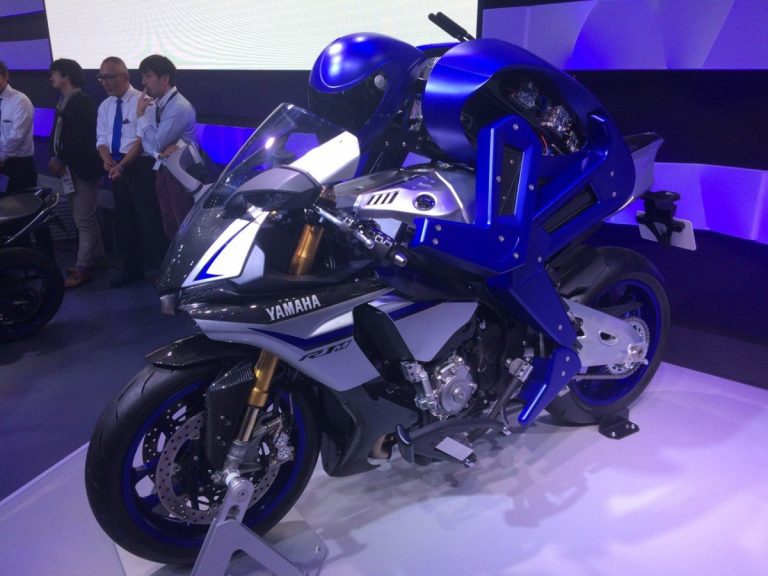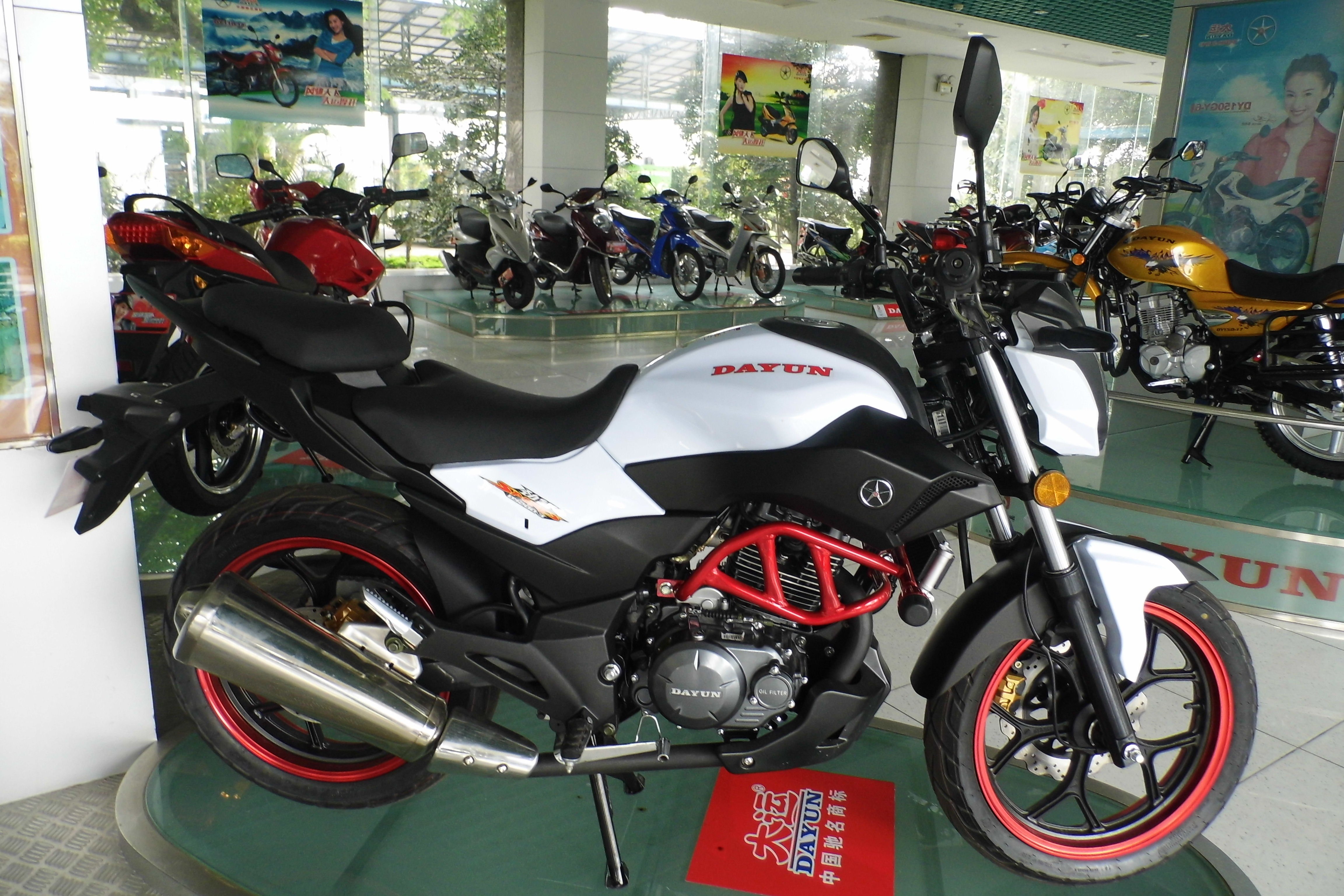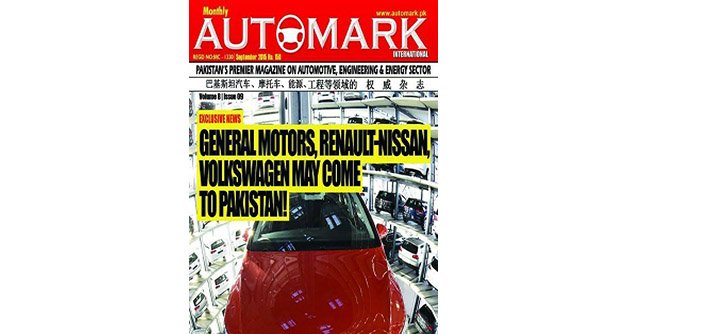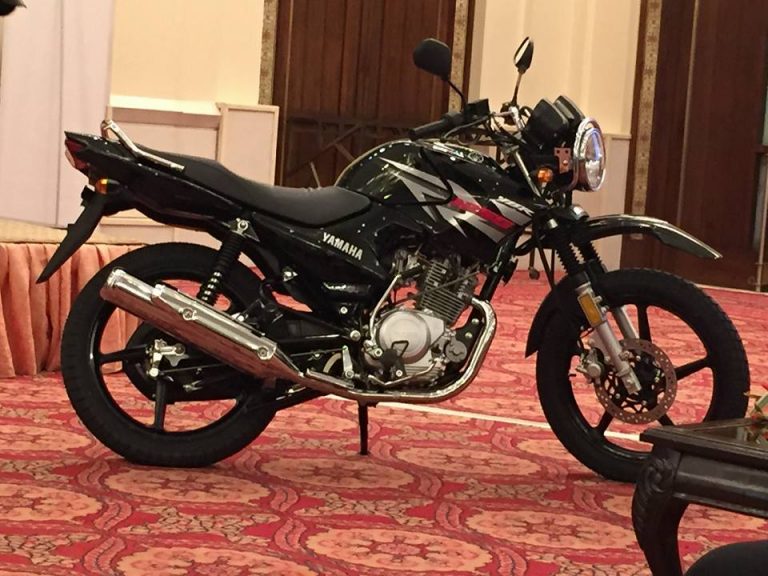DY200-3 Specs
| Item | Details |
| Size | 2070*780*1230 |
| Wheel base(mm) | 1363 |
| Net weight(kg) | 155 |
| Max load capacity(kg) | 150 |
| Front tire specifications | 100/80-17 |
| Rear tire specifications | 130/70-17 |
| Max. speed | ≥95 |
| Engine | 200cc |
| Bore and stroke(mm) | Φ66×57.8 |
| The maximum net power and corresponding speed [kW/(r/min)] | 10.5/7500 |
| The maximum torque and corresponding speed [N.m/(r/min)] | 15.5/5500 |
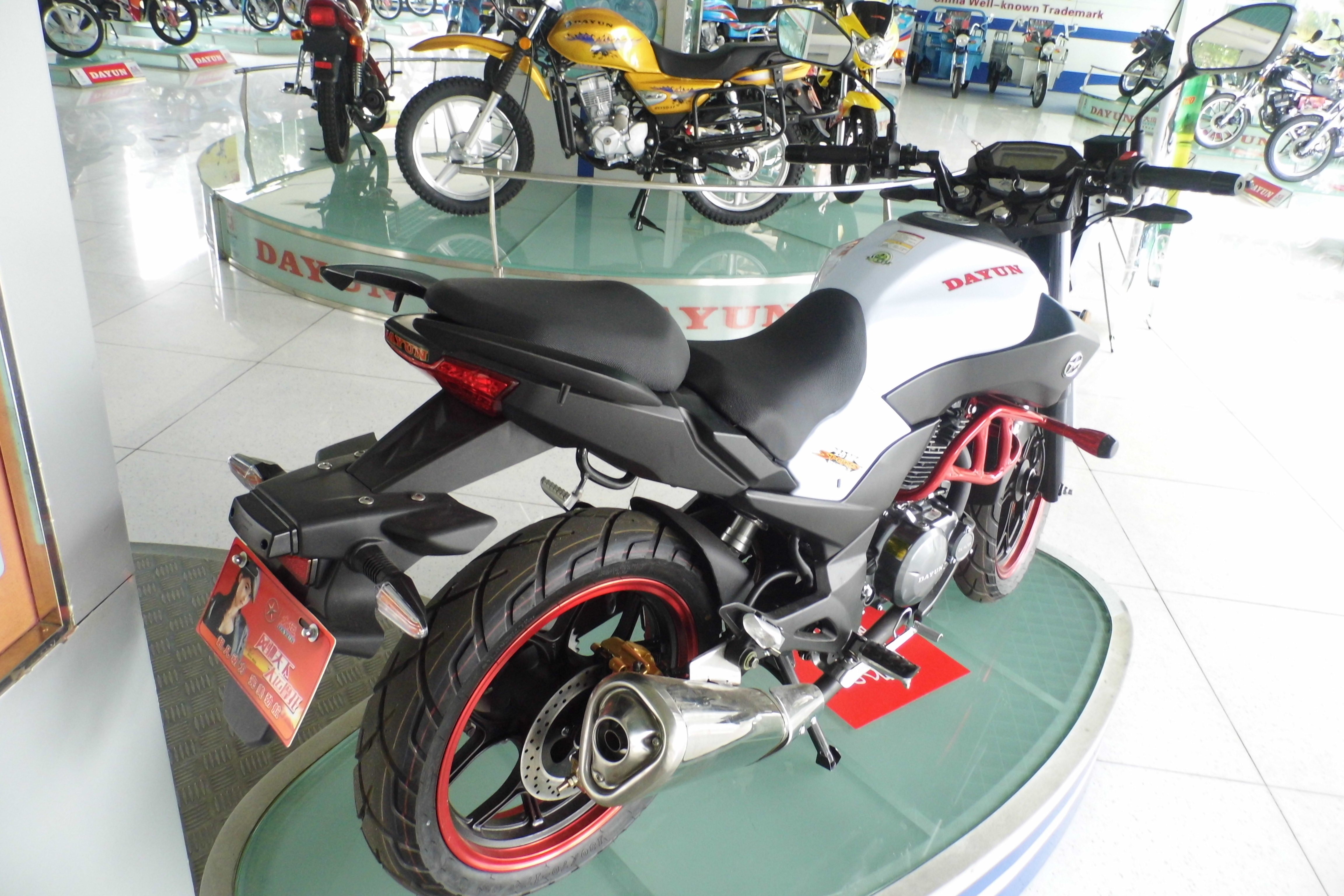
Meet The Yamaha Motobot: A Humanoid Robot That Will Learn To Ride Motorcycles Better Than Humans Can
Yamaha is delving into the world of autonomous vehicles in a way fitting of the unique company that it is: by building a robot capable of piloting a motorcycle better than a human can—but not just any human: nine-time MotoGP champion Valentino Rossi, who won this year’s championship on a Yamaha YZR-M1 and who some consider practically super-human.
In one of the most astounding announcements at this year’s Tokyo Motor Show that, nevertheless, was somehow overshadowed by other unveilings—including the Hyundai IDS Concept and even Yamaha’s own Sports Ride Concept—the Japanese maker of motorcycles and musical instruments revealed an “autonomous motorcycle-riding humanoid robot” called Motobot.
The blue, human-shaped machine has stationary arm- and leg-like appendages. It also has a head, and the entire robot is mounted atop the company’s flagship YZF-R1 motorcycle, looking very much like a professional MotoGP racer crouching low toward the handlebars to accelerate down a racetrack.
Yamaha’s goal with the Motobot project is to apply three decades of know-how creating assembly robots for industrial applications in a thinking machine of another sort.
Most robots in use today perform a single task with precision beyond what a human can do, such as joining together two heavy metal parts and creating a series of precise welds in a matter of seconds, for example, or torquing down 20 bolts at varying levels of tightness, all at once and with exacting precision.
Motobot, however, is far more complicated. It must be capable of performing innumerable fine adjustments to control the complex motions of a motorcycle—something humans can do relatively easily, but robots cannot.
The project is not an end unto itself, though. Yamaha plans to apply what it learns in building Motobot to improve its other lines of business, which include motorcycles, snowmobiles, ATVs, musical instruments, industrial robots, and more.
“We want to apply the fundamental technology and know-how gained in the process of this challenge to the creation of advanced rider safety and rider-support systems, and put them to use in our current businesses, as well as using them to pioneer new lines of business,” Yamaha said in a release announcing the Motobot.
So while other automakers are focusing their attention on making vehicles autonomous, Yamaha is looking instead to creating autonomous robots that can pilot a regular vehicle, such as a motorcycle, without modification. The potential for robotic chauffeurs comes to mind, but Yamaha did not make mention of such plans.
Motobot has six actuators for the steering, throttle, front brake, rear brake, clutch and gearshift pedal. Eventually, the goal is to employ high-precision GPS, various sensors and artificial intelligence—what Yamaha calls “machine learning”—to “enable Motobot to make its own decisions regarding the best lines to take around a racetrack and the limits of the motorcycle’s performance, so that it can improve its lap times with successive laps of the track,” the company said.
By the end of this year, Yamaha aims to have Motobot capable of cornering, running a slalom course, and riding in a straight line up to 62 miles per hour. By 2017, the goal is to have Motobot lap a racetrack at 124 miles per hour or higher and start to develop capabilities that exceed those of a human rider.
Yamaha anticipates that Motobot will be adaptable to other vehicles like snowmobiles and personal watercraft. By 2020, the company hopes to start incorporating technology and learnings from the Motobot project into consumer products.
“By using Motobot technologies to optimize control of vehicle dynamics, we will develop higher performing and safer forms of mobility,” the company said.
In total, Yamaha unveiled six world debuts at the Tokyo Motor Show, besides the Motobot. These include a sports car design study called the Sports Ride Concept, a three-wheeled motorcycle called the MWT-9, two electric motorcycles—including one called the PES2, with innovative two-wheel drive—an electric mountain bike, and a retro-styled motorcycle called the Resonator125.
The 2015 Tokyo Motor Show opened to the public October 30, following two press days, and runs through November 8.
DY125-20 Specs
| Item | Details |
| Size | 1925*700*1120 |
| Wheel base(mm) | 1240 |
| Net weight(kg) | 105kg |
| Max load capacity(kg) | / |
| Front tire specifications | 2.50-17 |
| Rear tire specifications | 2.75-17 |
| Max. speed | ≥85 |
| Acceleration noise[dB(A)] | |
| Climbing ability(°) | |
| Fuel Consumption(L/100km) | |
| Engine | 125cc |
| Bore and stroke(mm) | φ52.4×57.9 |
| The maximum net power and corresponding speed [kW/(r/min)] | 6.0kW/7000r/min |
| The maximum torque and corresponding speed [N.m/(r/min)] | 9.7n.m/5000r/min |
Since Last Three Govt’s No New Auto Policy in Pakistan
AUTO INDUSTRY POLICY 2005 – 06, TO 2015-16
The Govt. of Pakistan is going to maintain new records of Auto Sector manufacturers through Engineering Development Board (EDB), which has written a letter to the Association of Pakistan Motorcycle Assemblers, The Pakistan Automotive Manufacturers Association, the Pakistan Association of Automotive Parts and Accessories Manufacturers and to provide company-wise employment position in the sector.
The EDB said it is compiling data on employment position in the automotive sector of Pakistan. The purpose is to ascertain and update employment position in the auto sector and utilize the same in policy-making, the EDB added. The Govt. requires company-wise employment position covering permanent, contractual and daily-wagers on priority basis, the letter said.
Car and bike-assemblers also claim to have provided huge employment directly or indirectly after achieving up to 70 per cent localisation component in cars and light commercial vehicles (LCVs), 90pc in case of bikes and tractors and 45pc in heavy vehicles. “The auto world has changed a lot and leading Pakistani assemblers stand at the same old position and were rolling out two to three decade-old bikes and cars,” Chairman APMA said.
After change in government in 2008, local rupee started to losing the strength against the various currencies especially the US Dollar, Japanese Yen and Chinese Yuan. Moreover purchasing power of people started declining. As a result, the Chinese bike assemblers failed to push up the rates due to intense competition among themselves. Less than 10 assemblers managed to succeed in the stiff competition while around 40 units have been struggling to survive while some had packed up their business.
Due to lack of mass transport project in Karachi and other big cities consumers dependent on two wheeler and around 50 per cent buyers purchase bikes on installment basis.
He hailed the Metro Bus Project introduced in Lahore and Rawalpindi Islamabad recently which would benefit hugely to the general public. He urged the government to introduce similar project or circular railway for Karachi city.
Sabir Shaikh said he was much hopeful from the current government for being heard their grievances and suggestions in the policy making but the government maintained the same attitude which had been in vogue since 2006.
“I guarantee if our suggestions are given due considerations in the auto sector then this will definitely end up corruption on imports through smuggling of auto parts will also stop,’ he said adding that uniform policy will lure foreign and private investments and the industry will grow. What is uniform policy? One tax on CKD’s and Commercial Imports of Auto Sector and the other Tax on CBU’s.
“The government has to end up the monopoly of Japanese car and bike assemblers in order to flourish the local industry otherwise the situation will remain the same,” Sabir said.
For the import of CBU bikes, no separate policy had been announced for the last 25 years. This is a big segment which could generate more revenues for the government. Many assemblers are importing over 100cc bikes in 100 per cent CKDs and marketing their products as locally made products.
Since 2010-11, when the last auto policy expired (2005-06 to 2010-11), the country’s third-largest taxpaying sector has been working without updated guidelines.
The policy is said to be in the making. It is not clear how much more time the process will take, but according to high level sources, the policy draft has already been finalised and its summary has been forwarded for clearance to the Economic Coordination Committee (ECC).
The chairman Association of Pakistan Motorcycle Assemblers, Muhammad Sabir Shaikh said that we have no information about changing for motorcycle industry in upcoming Auto Policy, because no one invite us in last few meetings of new Auto Policy including August 07, meeting in EDB.
An assessment report of the Competition Commission of Pakistan (CCP), released in the month of October 2014, confirmed the undesirable dominant market position of the assemblers, to the chagrin of car users in the country.
In November 2014, the CCP had reportedly sought liberalised import of used cars and suggested increasing their age limit from three to five years to induct market competition.
The leading carmakers, operating their plants round the clock, have failed to catch up with the pace of growth in domestic demand. In the absence of options, buyers pay higher for a vehicle that lags in quality and safety standards. Often, the cars are delivered up to four months after the payment.
The said report noted that “the Pakistani automobile industry is inward-looking and tries to protect itself through the use of regulatory instruments. Pakistan needs to develop the automobile industry instead of protecting it, and in this regard imports will have a disciplinary impact on domestic firms”.
Keen to get a foothold in Pakistan’s auto market, a delegation from German auto giant Volkswagen was in the country a few weeks back. The company’s spokesman, Christoph Adomat, told the press that while “Volkswagen is constantly evaluating market opportunities on a worldwide basis, there are no decisions for an investment by the Volkswagen side in Pakistan”.
“The industry is operating in a very challenging environment. It is wrong to counterpose the interests of the local automakers and the consumers. The perception of dearer, low quality vehicles is a myth. People must not forget that the tax component in a vehicle’s price is as high as 35pc. This means that a 1000cc car priced at Rs1m currently can be sold for Rs. 650,000 if the government foregoes taxes,” the same situation in motorcycle, the 70 CC bike assembled by a small assembler costs Rs. 38,000/= including the Tax amount of Rs. 10,000/=. It means the price of small 70 CC bike is Rs. 28,000/=.
After the approval of finance bill 2015-2016 by national assembly, the new shape of SROs 656/2006, SRO 693/2006 and SRO 655/2006 also arrived. APMA Chairman, Muhammad Sabir Shaikh said the bike industry was highly hopeful from the current government that it would bring down the customs duty besides introducing unified customs duty coupled with reduction in sales tax by at least one to two percent. However, nothing was done in the budget. He hoped that finance minister must be thinking to take some steps for the bike industry on the above issues.
He expressed his concern over the persistent delay in AIP whose exercise between the industry and the government got underway from October 2013 to August 2015. He urged the government to settle the dust by announcing the policy either in the Trade Policy or separately so that the industries could make further investment.
APMA believes that FBR must understand that the government has to phase out auto sector SROs in the next two three months. Otherwise, two to three more years would again go in waste in understanding the issue.
APMA the government wants direct impact of taxation measures to reach the end users. However, it is only possible when government introduces a uniform policy for both large scale and SMEs. There is a need to remove hurdles of IORC besides bringing uniformity in valuation system, removing the hurdles like production certificates and importable lists by the EDB etc. This will help the industries to introduce new models at affordable prices.
All the policies and SROs made in the last 30 years were not in the interest of the country, not revenue-oriented and were basically following an anti localization policy and also against the industrialization and employment. Government should focus in the Auto Industry Policy on two types of duties – duty on spare parts (for OEMs, commercial market, assemblies, sub assemblies, components and sub components) and secondly on completely built up units (CBU’s).
APMA strongly urged that issuance of various permissions through EDB such as importable lists; production certificates and IORC should be done away in coming auto industry policy. All over the country the dealers of auto sector and parts should be registered in the sales tax net.
The committees formed by finance minister under FBR in which FPCCI and some other chambers were the members is not enough as there is a need to induct more experts of the field including Motorcycle Industry of Pakistan.
The government must give its due attention to the two wheeler segment this year especially and efforts should be made to pressurize leading assemblers to bring a change in the decades old 70cc models. Policy hurdles, if removed, would encourage assemblers to introduce new models in the country.
The government should realize that the main stakeholders are motorcycle assemblers of Pakistani and Chinese domestic brands who are producing more than one million units of two wheelers annually for the last many years. The more than 50 approved units of two wheelers, out of 104 are producing Pakistani brands in collaboration with Chinese assemblers. It seems that the AIP is being made at facilitating only three Japanese car and bike assemblers. Does the new auto policy really care about country’s revenue, industries, job opportunities, genuine localization etc? This is million dollar question and yet to be replied by the policymakers.
The industry is quite stunned by the media report that AIDP II policy has been finalized without bringing all stakeholders on board and will be reviewed by Economic Coordination Committee (ECC) of the federal cabinet.
They pointed out that ECC in its meeting on August 26, 2014 had deferred the decision on the policy with the direction that the policy draft should be shared with all stakeholders including relevant ministries and industries for review and comments.
Later, the policy was sporadically discussed by the architects with some stakeholders only. The industry experts expressed concern that the EDB has hoodwinked the ECC and despite its direction to share the proposed long term AIDP and record their views, “neither Pakistan Association of Auto Parts Manufacturers nor Association of Pakistan Motorcycle Assemblers, and Including Japanese Assemblers body Pakistan Automotive Manufacturers Association has received any final draft of the Auto Policy,” the stakeholders said.
They said EDB or the committee assigned to prepare the policy have the right to formulate it but they should share the final draft with all the stakeholders irrespective of the fact that the suggestions given by them are being incorporated or not.
They said views of all the stakeholders should be part of the final draft and reasons for rejecting the suggestions of each stakeholder should be discussed and justified.
The long term policies of any industrial sector are formulated with the main objective of protecting the domestic industry, they said, adding that the interests of consumers should also be given weight.
Moreover, even in cases where vendors offer to delete some auto components, the new entrants fail to provide the drawings.
The reason is that they procure parts of different manufacturers from the open market as because of very low volumes, and do not develop any auto components locally. In AIDP I (2006-11), only those entrants were allowed that produce at least 500,000 cars globally in a year outside Pakistan. “But, now even those that produce 5,000 units outside Pakistan are allowed to enter the Pakistan market on huge concessions,” the Auto Sector spokes person said.
This exclusive article on Pakistan Automotive sector published in Monthly Automark Magazine’s September-2015 printed edition
YAMAHA YBR 125G-First Look
Following the launch of its first model YBR125, Yamaha launched second of the first three 125cc models, YBR 125G. Yamaha had stunned the Pakistani motorcycle community by the launch of its first model and hence people were anxiously waiting for the launch of the second model. Most of the riding community already knew that the next model would be the 125G, the trail version and thanks to the internet we already knew what the upcoming bike would look like. Shockingly, however, Yamaha stunned the biker community once again although this time to their disappointment since the trail version turned out to be nothing more than a little face uplift of the regular YBR125 model. Nonetheless, some of us Pakistan Bikers Club members decided to visit a local show room and see the bike in person.
There is literally no difference at all between the YBR125 and YBR125G, with the exception of a round light and a raised front fender on the G version and slightly different dual-purpose tyres, everything else on the G version is same as the regular model. YBR 125G comes with the same OHC engine and produces a similar torque as the regular model so there is no increase in torque as some might have expected. Fork travel is almost the same for both models though YBR 125G has a slightly more ground clearance than the regular model, which is only because of the higher profile dual purpose front tyre, but the ground clearance that is typical feature of an off road bike is missing here. There is no hand protection on the handle bar, which obviously is an essential part of an off-road bike and is readily available on the YBR 125G sold across the world. The tank and tail is also borrowed from the regular 125 model, here Yamaha seems to have started following the crooked tactics of other manufacturers, i.e. saving the production cost by using same parts as on other models. Internationally, the YBR 125G comes with a windshield over the headlight and although Yamaha Pakistan did put the mount there perhaps they were in a rush to launch the bike that they forgot to put the windshield there altogether and the naked mount looks pretty hideous. Coming to the price, YBR 125G has been priced at Rs.132400/-, which is exactly Rs. 3000/- higher than the regular model, apparently the increased price is not justified considering that the round light has replaced a stylish diamond shape light, which is obviously costlier than the round shape light.
There is no extra light on the 125G and the riders are left to the mercy of the same 12V 35W halogen bulb. The stylish chain cover had impressed us all when we saw it on the YBR125 a few months ago, but perhaps Yamaha took our appreciation for a good excuse to put it on the 125G too, although this time it was highly disappointing. I tried hard to recall an off road bike that came with a fully covered chain and soon gave up. The YBR 125G can hardly be called an off-road bike, it is essentially a road bike trying hard to give the look of an off-road bike. My commiserations to the off-road bike lovers who were waiting for Pakistan’s first locally manufactured pure off-road bike, this is not it.
Exclusive Article written for Monthly Automark Magazine by Tala Hussain Malik, Member www.pakistanbikersclub.com
Local assembled Suzuki Heavy Bike Inazuma 250cc launched in Pakistan
Pak Suzuki is planting new seeds into the soil of Pakistan by locally assembling their already existing Suzuki Inazuma. Launching ceremony of the locally assembled Suzuki Inazuma 250cc was held last night at Serena hotel, Islamabad. The bike was previously manufactured and assembled in Japan only but seems like Suzuki found out a feasible way of locally assembling it.
Suzuki Inazuma is a four stroke, liquid cooled 248cc engine motorbike with a fuel capacity of 13.3 liters. With coil springs fitted both at the rear and front, the bike is quite comfortable and smooth at bumps and jumps.
Surely no change in the specifications will be done but the quality will be questionable as local manufactured products lack the quality, the case applies to all the automakers operating in Pakistan. In regards to the price it is expected to be lower than the already attached price tag of PKR 725,000.
Pak Suzuki aims to get huge orders from security institutions of the country as they have been playing an active part in attaining discipline for the state and the need is felt by the automaker. If you notice bike fever has increased considerably over the couple of years and KPK traffic police was nowhere behind. The KPK police recently gave handful of brand new Suzuki Inazuma to their police. Although Suzuki Inazuma stands lowest in the power league bikes but still has enough power to eat many 125cc and 200cc.
Cloud-Based Warning System Could Curb Wrong-Way Driving Deaths
Cloud-Based Warning System Could Curb Wrong-Way Driving Deaths
What if there were a quick and simple system that alerted all drivers when someone was driving the wrong way down the road?German automotive supplier Bosch aims to better warn wrong-way drivers, both those actually driving the wrong way and those near the cardriving the wrong way, using a cloud-based software application.
The premise is that Bosch provides a software application that constantly checks avehicle’s movements against what it understands as the permitted direction on any given road. Imagine itlike any other GPS software, but with a specific focus on which way the car is moving. If the information gathered from the vehicles doesn’t line up with the way they should be driving, that’s when an alert goes out to both that driver and any oncoming drivers utilizing the system.
According to Bosch, radio alerts in Germanyaboutwrong-way driverscan take several minutes to go out, by which time the danger’s already come and gone for most folks. A statistic they quote says that one third of criticalincidents caused by wrong-way drivers occurs within the first 1,650 feet or so, meaning that an accident’s already happened in these cases before there’s ever a radio-based warning. Thus the cloud-based system they’re working on, which would alert folks much faster.
One potential flaw in the system: It’s only as good as the number of vehicles using it. Part of the way it detects and alerts folks of wrong-way drivers appears to be tied up in information gathered anonymously from nearby vehicles. This also would be completely ineffective for anyone driving around without the software application, or without “an unbroken connection to the internet,” which is something it requires to function.
The service is scheduled to launch in 2016, and will be made available for as many “infotainment” devices as possible, in hopes of casting awide safety net. In the meantime,don’t drive downstreets the wrong way. That could help too.



